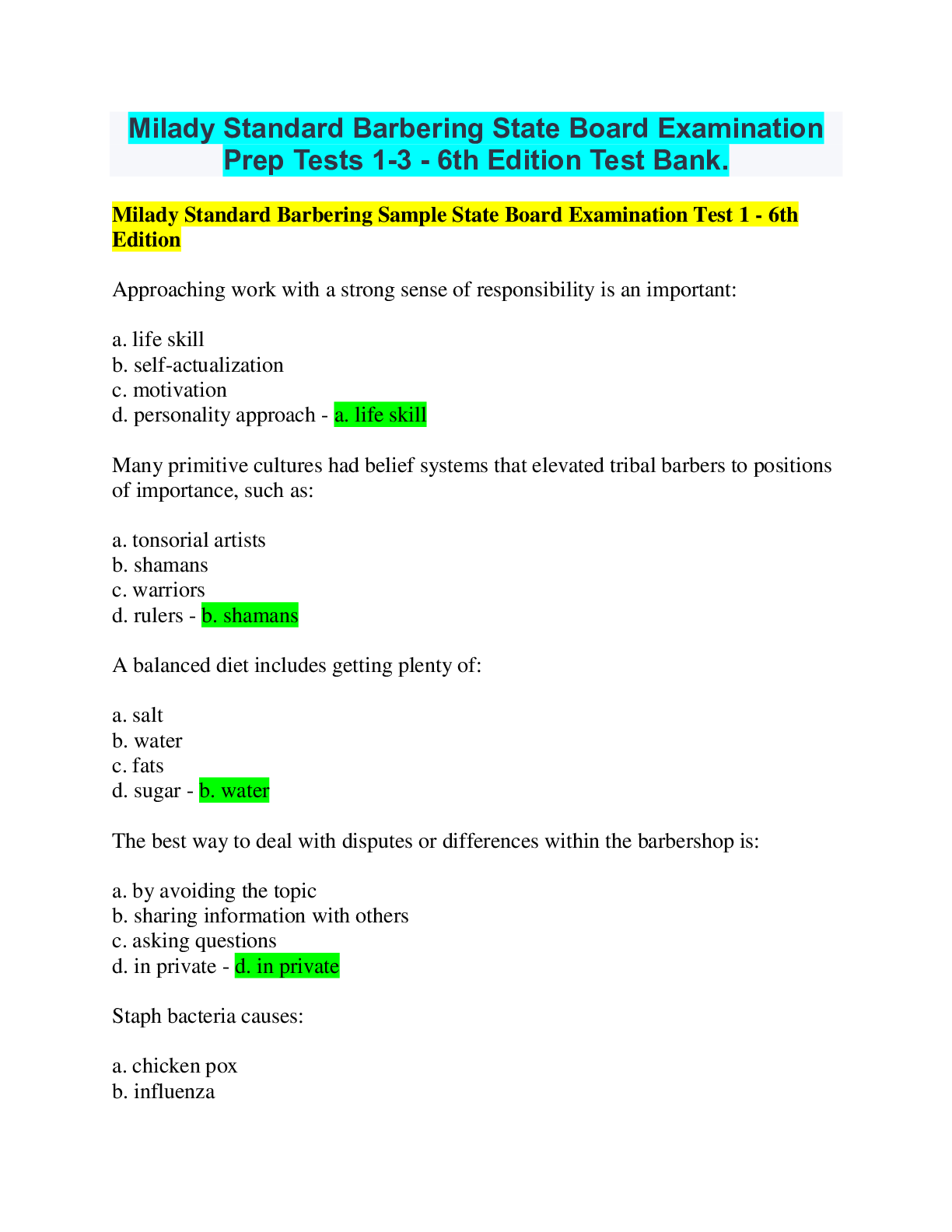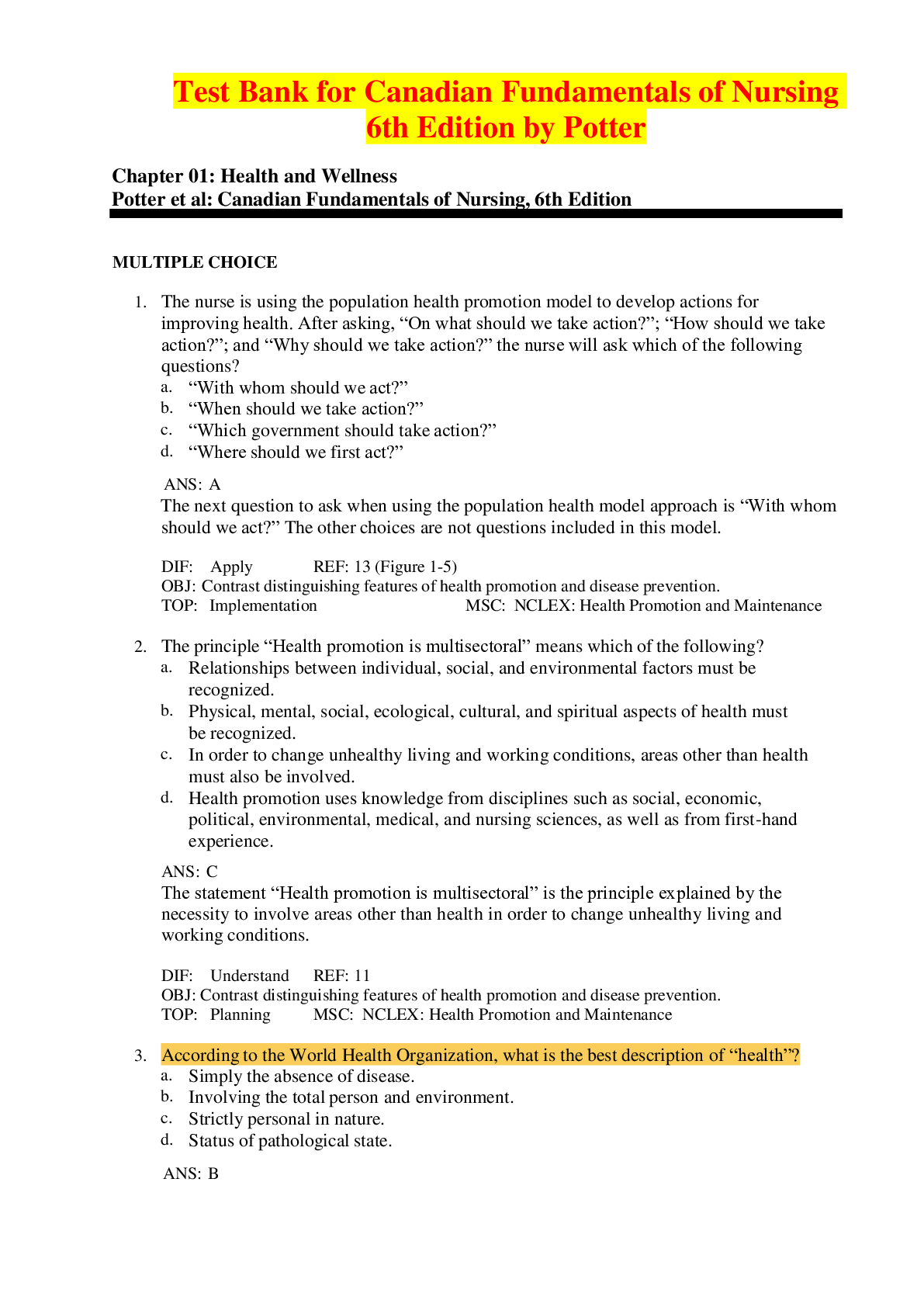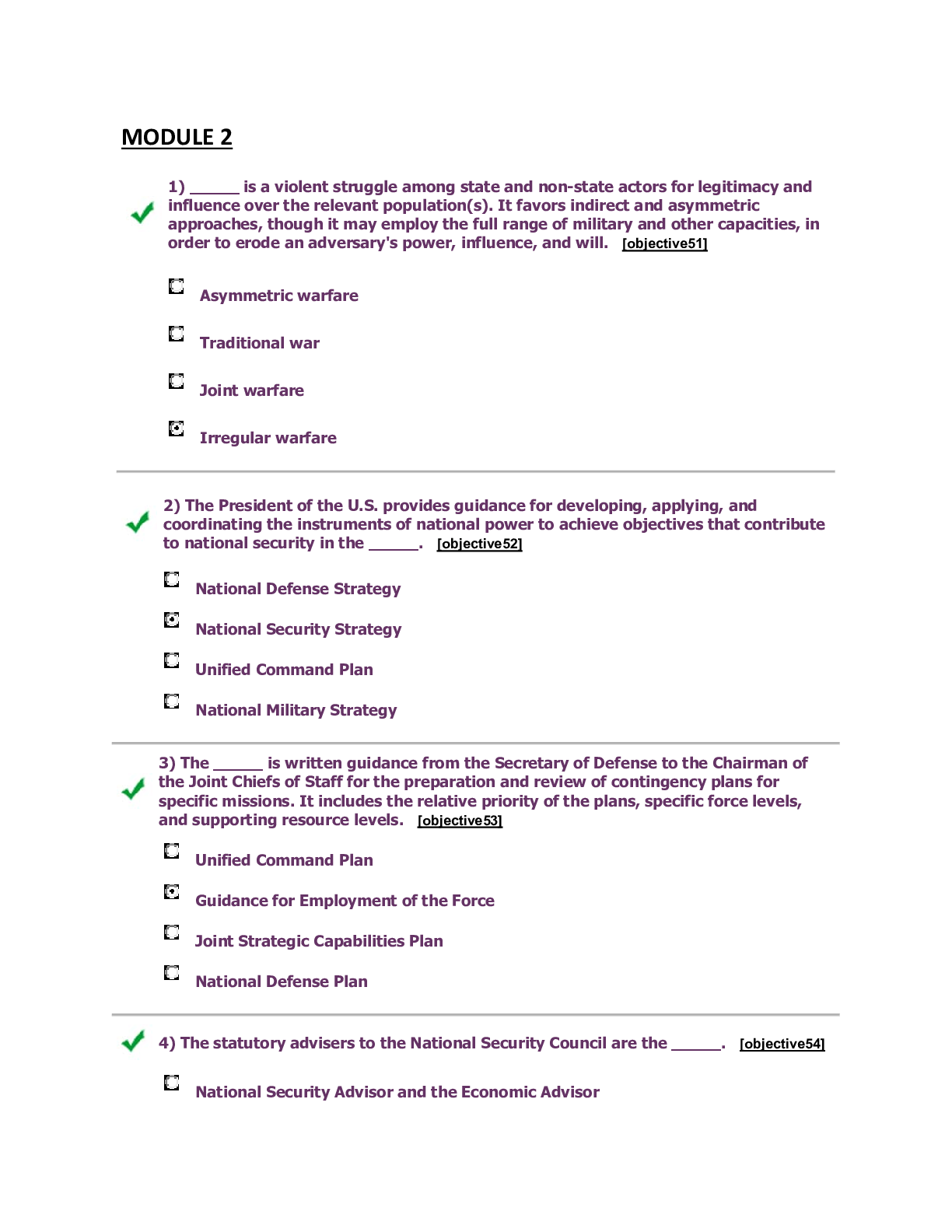*NURSING > TEST BANKS > Buttaro: Primary Care, A Collaborative Practice, 5th Edition | Test Bank For Primary Care A Collabor (All)
Buttaro: Primary Care, A Collaborative Practice, 5th Edition | Test Bank For Primary Care A Collaborative Practice, 5th Edition : all chapters (chapter 1 - chapter 250) Questions, answers with rationales> created by experts to help you with your exams.
Document Content and Description Below
Test Bank For Primary Care A Collaborative Practice, 5th Edition :Buttaro: Primary Care, A Collaborative Practice, 5th Ed. Chapter 1: The Evolving Landscape of Collaborative Practice Test Bank Multi... ple Choice 1. Which assessments of care providers are performed as part of the Value Based Purchasing initiative? Select all that apply. a. Appraising costs per case of care for Medicare patients b. Assessing patients’ satisfaction with hospital care c. Evaluating available evidence to guide clinical care guidelines d. Monitoring mortality rates of all patients with pneumonia e. Requiring advanced IT standards and minimum cash reserves ANS: A, B, D Value Based Purchasing looks at five domain areas of processes of care, including efficiency of care (cost per case), experience of care (patient satisfaction measures), and outcomes of care (mortality rates for certain conditions. Evaluation of evidence to guide clinical care is part of evidence-based practice. The requirements for IT standards and financial status are part of Accountable Care Organization standards. REF: Value Based Purchasing 2. What was an important finding of the Advisory Board survey of 2014 about primary care preferences of patients? a. Associations with area hospitals b. Costs of ambulatory care c. Ease of access to care d. The ratio of providers to patients ANS: C As part of the 2014 survey, the Advisory Board learned that patients desired 24/7 access to care, walk-in settings and the ability to be seen within 30 minutes, and care that is close to home. Associations with hospitals, costs of care, and the ratio of providers to patients were not part of these results. REF: The New Look of Primary Care 3. A small, rural hospital is part of an Accountable Care Organization (ACO) and is designated as a Level 1 ACO. What is part of this designation? a. Bonuses based on achievement of benchmarks b. Care coordination for chronic diseases c. Standards for minimum cash reserves d. Strict requirements for financial reporting ANS: A A Level 1 ACO has the least amount of financial risk and requirements, but receives shared savings bonuses based on achievement of benchmarks for quality measures and expenditures. Care coordination and minimum cash reserves standards are part of Level 2 ACO requirements. Level 3 ACOs have strict requirements for financial reporting. REF: Accountable Care Organizations Chapter 2: Transitional Care Test Bank Multiple Choice 1. To reduce adverse events associated with care transitions, the Centers for Medicare and Medicaid Service have implemented which policy? a. Mandates for communication among primary caregivers and hospitalists b. Penalties for failure to perform medication reconciliations at time of discharge c. Reduction of payments for patients readmitted within 30 days after discharge d. Requirements for written discharge instructions for patients and caregivers ANS: C As a component of the Affordable Care Act, the Centers for Medicare and Medicaid Service developed the Readmissions Reduction Program reducing payments for certain patients readmitted within 30 days of discharge. The CMS did not mandate communication, institute penalties for failure to perform medication reconciliations, or require written discharge instructions. REF: Transitional Care 2. According to Naylor’s transitional care model, which intervention has resulted in lower costs and fewer rehospitalizations in high-risk older patients? a. Coordination of post-hospital care by advanced practice nurses b. Frequent post-hospital clinic visits with a primary care provider c. Inclusion of extended family members in the outpatient plan of care d. Telephone follow up by the pharmacist to assess medication compliance ANS: A Naylor’s transitional care model provided evidence that high risk older patients who had post- hospital care coordinated by an APN had reduced rehospitalization rates. It did not include clinic visits with a primary care provider, inclusion of extended family members in the plan of care, or telephone follow up by a pharmacist. REF: Transitional Care 3. Which approaches are among those recommended by the Agency for Healthcare Research and Quality to improve health literacy in patients? Select all that apply. a. Empowering patients and families b. Giving written handouts for all teaching c. Highlighting no more than 7 key points d. Repeating the instructions e. Supplementing teaching with visual aids ANS: A, D, E AHRQ recommends using clear, simple language, highlighting 3 to 5 key points, using pictures or visual aids, repeating the instructions, using Teach Back, and empowering patients. Written communication is not part of the recommendations. REF: Health Literacy Chapter 3: Translating Research Into Clinical Practice Test Bank Multiple Choice 1. Which is the most appropriate research design for a Level III research study? a. Epidemiological studies b. Experimental design c. Qualitative studies d. Randomized clinical trials ANS: B The experimental design is the most appropriate design for a Level III study. Epidemiological studies are appropriate for Level II studies. Qualitative designs are useful for Level I studies. Randomized clinical trials are used for Level IV studies. REF: Level III Research/Experimental Design 2. What is the purpose of clinical research trials in the spectrum of translational research? a. Adoption of interventions and clinical practices into routine clinical care b. Determination of the basis of disease and various treatment options c. Examination of safety and effectiveness of various interventions d. Exploration of fundamental mechanisms of biology, disease, or behavior ANS: C Clinical research trials are concerned with determining the safety and effectiveness of interventions. Adoption of interventions and practices is part of clinical implementation. Determination of the basis of disease and treatment options is part of the pre-clinical research phase. Exploration of the fundamental mechanisms of biology, disease, or behavior is part of the basic research stage. REF: Translational Science Spectrum 3. What is the purpose of Level II research? a. To define characteristics of interest of groups of patients b. To demonstrate the effectiveness of an intervention or treatment c. To describe relationships among characteristics or variables d. To evaluate the nature of relationships between two variables ANS: C Level II research is concerned with describing the relationships among characteristics or variables. Level I research is conducted to define the characteristics of groups of patients. Level II research evaluates the nature of the relationships between variables. Level IV research is conducted to demonstrate the effectiveness of interventions or treatments. REF: Level II Research Chapter 4: The Patient, the Provider, and Primary Care: An Integrated Perspective Test Bank Multiple Choice 1. A patient takes glucosamine chondroitin to help control osteoarthritis pain. Which medications, taken in conjunction with this medication, are of concern? a. Anticholinergic drugs b. Beta blocker medications c. Blood-thinning agents d. Narcotic analgesics ANS: C Glucosamine chondroitin can prolong bleeding if taken with other blood-thinning agents. It does not have anticholinergic effects, cardiac effects or analgesic effects. REF: Alternative Therapies for Common Chronic Conditions/Joint Pain 2. The provider learns that a patient is taking herbal supplements for a variety of reasons. What is an important point to discuss with this patient about taking such supplements? a. Because they are not FDA approved, they are not safe b. Dietary supplements are safer than most prescription medications c. Many supplements lack clear clinical evidence of efficacy d. Supplements should not be taken with prescription medications ANS: C Many dietary supplements lack clinical evidence to support their use. Even though they are not FDA approved, federal law mandates that the products are safe and cannot make misleading claims about use. Supplements are not necessarily safer than prescription drugs. Supplements may be taken with prescription medications as long as the effects, side effects, and drug interactions are known. REF: Alternative Therapies for Common Chronic Conditions 3. Which dietary supplements have shown some effectiveness in reducing blood pressure in patients with hypertension? Select all that apply. a. Chromium picolinate b. Cinnamon c. CoQ10 d. Garlic extract e. L-arginine ANS: C, D, E CoQ10, garlic extract, and L-arginine have demonstrated effectiveness in reducing blood pressure in some studies. Chromium picolinate and cinnamon have been studied for effects on glucose tolerance and fasting glucose. REF: Alternative Therapies for Common Chronic Conditions/Prehypertension and Hypertension Chapter 5: Population-Based Care for Primary Care Providers Test Bank Multiple Choice 1. Which are key components of the Patient-Centered Medical Home? Select all that apply. a. Access to care b. Comprehensive care c. Coordination of care d. Provision of care by a single provider e. Storage of medical records ANS: A, B, C The Patient-Centered Medical Home is a team-based approach to providing care that is accessible, comprehensive, coordinated, longitudinal and high quality. It is not provided by a single provider, but is managed as a team. The original concept had to do with where medical records are stored, but this is not the working definition today. REF: The Patient-Centered Medical Home 2. The chronic care model (CCM) was developed to manage patients with complicated chronic conditions because the traditional acute care model a. could not provide efficient and cost-effective chronic care. b. did not meet longitudinal health care needs for this population. c. did not offer ambulatory care services for these patients. d. put patients and families at the center of care. ANS: B The chronic care model was developed based on the recognition that the traditional acute care model did not meet longitudinal health care needs of patients with chronic and complicated conditions, not because of inefficiencies or costs. The traditional model does include ambulatory care, but that is not the focus. The traditional model does not typically place patients at the center of care. REF: Chronic Care Model 3. What are functions of patient registries in the chronic care model? Select all that apply. a. Alerting providers to medication interactions b. Identifying appropriate specialists for referral c. Recommending routine screenings d. Reminding providers about immunizations e. Transmitting clinical data about patients ANS: A, C, D, E Patient registries are used to help manage patients at risk and include alerting providers about medication interactions, recommending routine screenings, reminders for immunizations, and transmitting clinical data. They are not used to identify or recommend providers or specialists. REF: Chronic Care Model/Clinical Information Systems Chapter 6: Health Literacy, Health Care Disparities, and Culturally Responsive Primary Care Test Bank Multiple Choice 1. A primary care provider administers the “Newest Vital Sign” health literacy test to a patient newly diagnosed with a chronic disease. What information is gained by administering this test? a. Ability to calculate data, along with general knowledge about health b. Ease of using technology and understanding of graphic data c. Reading comprehension and reception of oral communication d. Understanding of and ability to discuss health care concerns ANS: A The “Newest Vital Sign” tests asks patients to look at information on an ice cream container label and answer questions that evaluate ability to calculate caloric data and to grasp general knowledge about food allergies. It does not test understanding of technology or directly measure reading comprehension. It does not assess oral communication. The “Ask Me 3” tool teaches patients to ask three primary questions about their health care and management. REF: Health Literacy Assessment 2. A female patient who is from the Middle East schedules an appointment in a primary care office. To provide culturally responsive care, what will the clinic personnel do when meeting this patient for the first time? a. Ensure that she is seen by a female provider b. Include a male family member in discussions about health care c. Inquire about the patient’s beliefs about health and treatment d. Research middle eastern cultural beliefs about health care ANS: C It is important not to make assumptions about beliefs and practices associated with health care and to ask the patient about these. While certain practices are common in some cultural and ethnic groups, assuming that all members of those groups follow those norms is not culturally responsive. REF: Address Cultural Variations Among Diverse Patient Groups 3. What is the main reason for using the REALM-SF instrument to evaluate health literacy? a. It assesses numeracy skills. b. It enhances patient-provider communication. c. It evaluates medical word recognition. d. It measures technology knowledge. ANS: C The REALM-SF is an easy and fast tool that measures medical word recognition. It does not evaluate numeracy. The “Ask Me 3” tool enhances patient-provider communication. This tool does not evaluate understanding of technology. REF: Health Literacy Assessment Chapter 7: Genetic Considerations in Primary Care Test Bank Multiple Choice 1. A patient expresses concern that she is at risk for breast cancer. To best assess the risk for this patient, what is the best initial action? a. Ask if there is a family history of breast cancer b. Gather and record a three-generation pedigree c. Order a genetic test for the breast cancer gene d. Recommend direct-to-consumer genetic testing ANS: B The three-generation pedigree is the best way to evaluate genetic risk. Asking about a family history is not a systematic risk assessment and doesn’t specify who in the family has the history or whether there is a pattern. Genetic testing and DTC genetic testing are not the initial actions when assessing genetic risk. REF: Gathering a Family History 2. A patient asks about direct-to-consumer (DTC) genetic testing. What will the provider tell the patient? a. It is not useful for identifying genetic diseases. b. Much of the information does not predict disease risk. c. The results are shared with the patient’s insurance company. d. The results must be interpreted by a provider. ANS: B DTC testing gives a lot of information, but much of it does not contribute to disease prediction, since mutations are not necessarily related to specific diseases. The tests are useful, but must be interpreted accurately. The results are confidential and do not have to be interpreted by a provider. REF: Direct-to-Consumer (DTC) Genetic Testing Buttaro: Primary Care, A Collaborative Practice, 5th Ed. Chapter 8: Risk Management Test Bank Multiple Choice 1. What are some causes for failures or delays in diagnosing patients resulting in malpractice claims? Select all that apply. a. Failing to recognize a medication complication b. Failing to request appropriate consultations c. Improper performance of a treatment d. Not acting on diagnostic test results e. Ordering a wrong medication ANS: B, D Failing to obtain consultations when indicated or not acting on diagnostic test results can lead to diagnosis-related failures. Failing to recognize medication complications and ordering a wrong medication lead to medication prescribing allegations. Improper performance of a treatment can lead to treatment related malpractice claims. REF: Nurse Practitioner Malpractice Claims 2. What is an important part of patient care that can minimize the risk of a formal patient complaint even when a mistake is made? a. Ensuring informed consent for all procedures b. Maintaining effective patient communication c. Monitoring patient compliance and adherence d. Providing complete documentation of visits ANS: B Effective patient communication is key to building trust and rapport and ineffective communication is a predictor for malpractice claims. The other items are important aspects of care and may help the provider during the investigation of a claim, but do not minimize the risk. REF: Communication Issues Chapter 9: Adolescent Issues Test Bank Multiple Choice 1. Which behavior is most characteristic of early adolescence? a. Arguing with parents and teachers b. Assimilating adult roles and thinking c. Exhibiting fatigue more frequently d. Experimenting with sex and risky behaviors ANS: A Early adolescents challenge authority, experience wide mood swings, reject the ideation of childhood, and can be argumentative and disobedient. Middle adolescents experience fatigue and begin experimenting with sex and risky behaviors. Late adolescents begin to assimilate adult roles. REF: Introduction 2. What is the initial sign of puberty in the adolescent male? a. Deepening of the voice b. Elongation of the penis c. Nocturnal emissions d. Testicular enlargement ANS: D Testicular enlargement is the initial sign of puberty in adolescent males. Penile growth and nocturnal emissions occur later as does deepening of the voice. REF: Physical Development 3. A parent reports that an adolescent child does well in school but seems to consistently make poor decisions about activities with friends. What will the practitioner recommend as an approach to help the adolescent make better decisions? a. Correcting the adolescent’s decisions and judgments b. Listening without making suggestions about choices c. Making decisions for the adolescent to provide guidance d. Providing factual information about appropriate behavior ANS: B Test Bank 2 Listening without correcting is the best approach to help adolescents learn to make good decisions. Correcting the decisions, making decisions for the adolescent, or giving information that is unsolicited are not recommended. REF: Cognitive Development Chapter 10: LGBTQ Patient Care Test Bank Multiple Choice 1. Which is the most important factor limiting access to health care for sexual and gender minorities? a. Lack of familial support for SGM members b. Laws prohibiting full marriage equality c. Risky coping behaviors among SGM members d. Social stigma about being in this population ANS: B Since most people get health insurance through their employer or their spouse s employer, states which do not allow full marriage equality limit access to health care for LGBTQ people. The other causes are important, but this is the leading cause. REF: Introduction 2. What is the medical diagnostic term used to identify transgender patients? a. Gender dysphoria b. Gender expression disorder c. Gender identity disorder d. Gender role unconformity ANS: A Gender dysphoria is the term used to identify transgender patients in order to justify the medical necessity of treatments for transgender patients. It replaces the previous “gender identity disorder” designation. REF: Access to Care **********CONTINUED*********************** [Show More]
Last updated: 2 years ago
Preview 1 out of 442 pages

Buy this document to get the full access instantly
Instant Download Access after purchase
Buy NowInstant download
We Accept:

Reviews( 0 )
$19.00
Can't find what you want? Try our AI powered Search
Document information
Connected school, study & course
About the document
Uploaded On
Apr 09, 2021
Number of pages
442
Written in
Additional information
This document has been written for:
Uploaded
Apr 09, 2021
Downloads
1
Views
275




_compressed.png)







.png)













